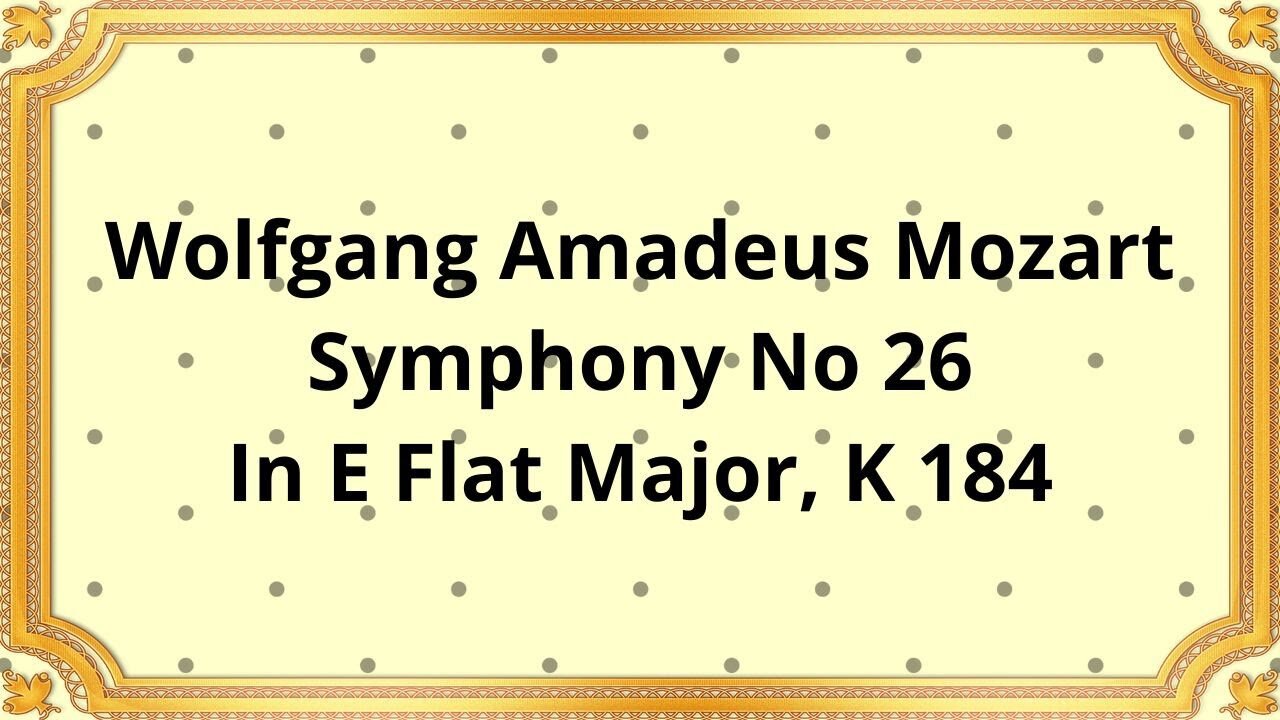Premium Only Content

Wolfgang Amadeus Mozart Symphony No 26 In E Flat Major, K 184
#Mozart#Chamber_music#Classical_music#Symphony#Musical_composition
Publication date 1953
Louis Kaufman, Violinist
Netherlands Philharmonic Orchestra
Otto Ackermann, Conductor
Wolfgang Amadeus Mozart Symphony No. 26 in E-flat Major, K. 184, is a stunning piece of classical music that was composed by the legendary Austrian composer, Wolfgang Amadeus Mozart. This symphony is one of the early works of Mozart and was composed in 1773 when he was just 17 years old.
The Symphony No. 26 is scored for two oboes, two horns, and strings. It is in three movements, with the first and last movements in the key of E-flat major, while the second movement is in C minor. The symphony is known for its beautiful melodies, harmonic structure, and use of counterpoint.
The first movement of the symphony, marked "Molto presto," is a lively and spirited piece that showcases Mozart's talent for creating catchy and memorable melodies. The opening theme is introduced by the strings and is then repeated by the oboes and horns. The development section of the movement features intricate counterpoint and virtuosic solo passages for the oboes and horns.
The second movement, marked "Andante," is a stark contrast to the first movement, with a somber and melancholic tone. The movement is in C minor, a key that Mozart often used to convey sadness and tragedy. The main theme is introduced by the strings and is then passed on to the oboe, who plays a beautiful solo.
The final movement, marked "Molto Allegro," is a joyous and uplifting piece that brings the symphony to a rousing conclusion. The movement features rapid-fire rhythms and virtuosic solo passages for the oboes and horns.
Overall, the Symphony No. 26 is an excellent example of Mozart's early style, characterized by lively melodies, intricate counterpoint, and virtuosic solo passages. The symphony is also a testament to Mozart's prodigious talent, as he was able to compose such a masterpiece at such a young age.
In terms of its historical context, the Symphony No. 26 was composed during a time of great change in classical music. The symphony is often classified as belonging to the "Mannheim School," a group of composers who were known for their use of dynamic contrasts, expressive melodies, and virtuosic solo passages.
In conclusion, Wolfgang Amadeus Mozart's Symphony No. 26 in E-flat Major, K. 184, is a masterpiece of classical music that showcases Mozart's prodigious talent and early style. Its catchy melodies, intricate counterpoint, and virtuosic solo passages make it a must-listen for any lover of classical music.
-
 4:24
4:24
Classical music_Music Inspiration
28 days agoFrederic Chopin Fantasy-Impromptu in C-sharp minor, Op 66
531 -

The Rubin Report
1 hour agoDonald Trump Reveals How He Pulled Off Impossible Israel-Hamas Peace Deal
4.32K5 -
 LIVE
LIVE
The Shannon Joy Show
1 hour agoAI Mega Bubble - $1 Trillion Tech Scheme Raises Red Flags - LIVE W/ Rocket Dollar CEO Henry Yoshida
187 watching -
 1:33:41
1:33:41
Dinesh D'Souza
12 hours agoDragon's Prophecy Film
14.8K11 -
 LIVE
LIVE
Right Side Broadcasting Network
3 hours agoLIVE: President Trump Hosts a Cabinet Meeting - 10/9/25
4,930 watching -
 LIVE
LIVE
The Mel K Show
1 hour agoMORNINGS WITH MEL K -Deja Vu? Decades of Crimes Without Consequences 10-9-25
202 watching -
 LIVE
LIVE
Grant Stinchfield
34 minutes agoTrump’s DOJ to Crush ANTIFA’s Cash Cows
130 watching -
 UPCOMING
UPCOMING
Trumpet Daily
43 minutes agoTrumpet Daily LIVE | Oct. 9, 2025
-
 1:00:11
1:00:11
VINCE
3 hours agoTrump's Greatest Deal Yet | Episode 143 - 10/09/25
133K65 -
 LIVE
LIVE
LFA TV
12 hours agoLIVE & BREAKING NEWS! | THURSDAY 10/9/25
4,245 watching
